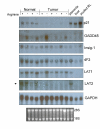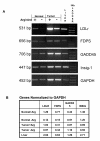Short-term arginine deprivation results in large-scale modulation of hepatic gene expression in both normal and tumor cells: microarray bioinformatic analysis
- PMID: 16961918
- PMCID: PMC1613245
- DOI: 10.1186/1743-7075-3-37
Short-term arginine deprivation results in large-scale modulation of hepatic gene expression in both normal and tumor cells: microarray bioinformatic analysis
Abstract
Background: We have reported arginine-sensitive regulation of LAT1 amino acid transporter (SLC 7A5) in normal rodent hepatic cells with loss of arginine sensitivity and high level constitutive expression in tumor cells. We hypothesized that liver cell gene expression is highly sensitive to alterations in the amino acid microenvironment and that tumor cells may differ substantially in gene sets sensitive to amino acid availability. To assess the potential number and classes of hepatic genes sensitive to arginine availability at the RNA level and compare these between normal and tumor cells, we used an Affymetrix microarray approach, a paired in vitro model of normal rat hepatic cells and a tumorigenic derivative with triplicate independent replicates. Cells were exposed to arginine-deficient or control conditions for 18 hours in medium formulated to maintain differentiated function.
Results: Initial two-way analysis with a p-value of 0.05 identified 1419 genes in normal cells versus 2175 in tumor cells whose expression was altered in arginine-deficient conditions relative to controls, representing 9-14% of the rat genome. More stringent bioinformatic analysis with 9-way comparisons and a minimum of 2-fold variation narrowed this set to 56 arginine-responsive genes in normal liver cells and 162 in tumor cells. Approximately half the arginine-responsive genes in normal cells overlap with those in tumor cells. Of these, the majority was increased in expression and included multiple growth, survival, and stress-related genes. GADD45, TA1/LAT1, and caspases 11 and 12 were among this group. Previously known amino acid regulated genes were among the pool in both cell types. Available cDNA probes allowed independent validation of microarray data for multiple genes. Among genes downregulated under arginine-deficient conditions were multiple genes involved in cholesterol and fatty acid metabolism. Expression of low-density lipoprotein receptor was decreased in both normal and tumor cells.
Conclusion: Arginine-sensitive regulation appears to be an important homeostatic mechanism to coordinate cell response and nutrient availability in hepatic cells. Genes predicted as arginine-responsive in stringent microarray data analysis were confirmed by Northern blot and RT-PCR. Although the profile of arginine-responsive genes is altered and increased, a considerable portion of the "arginome" is maintained upon neoplastic transformation.
Figures



Similar articles
-
TA1/LAT-1/CD98 light chain and system L activity, but not 4F2/CD98 heavy chain, respond to arginine availability in rat hepatic cells. Loss Of response in tumor cells.J Biol Chem. 2000 Feb 25;275(8):5347-54. doi: 10.1074/jbc.275.8.5347. J Biol Chem. 2000. PMID: 10681508
-
Redefinition of Affymetrix probe sets by sequence overlap with cDNA microarray probes reduces cross-platform inconsistencies in cancer-associated gene expression measurements.BMC Bioinformatics. 2005 Apr 25;6:107. doi: 10.1186/1471-2105-6-107. BMC Bioinformatics. 2005. PMID: 15850491 Free PMC article.
-
Control of expression of the gene for the arginine transporter Cat-1 in rat liver cells by glucocorticoids and insulin.Amino Acids. 1998;15(4):321-37. doi: 10.1007/BF01320897. Amino Acids. 1998. PMID: 9891757
-
Cooperation of liver cells in health and disease.Adv Anat Embryol Cell Biol. 2001;161:III-XIII, 1-151. doi: 10.1007/978-3-642-56553-3. Adv Anat Embryol Cell Biol. 2001. PMID: 11729749 Review.
-
Complexity, retinoid-responsive gene networks, and bladder carcinogenesis.Adv Exp Med Biol. 1999;462:449-67. doi: 10.1007/978-1-4615-4737-2_35. Adv Exp Med Biol. 1999. PMID: 10599447 Review.
Cited by
-
Targeting arginine-dependent cancers with arginine-degrading enzymes: opportunities and challenges.Cancer Res Treat. 2013 Dec;45(4):251-62. doi: 10.4143/crt.2013.45.4.251. Epub 2013 Dec 31. Cancer Res Treat. 2013. PMID: 24453997 Free PMC article. Review.
-
Beyond protein synthesis: the emerging role of arginine in poultry nutrition and host-microbe interactions.Front Physiol. 2024 Jan 3;14:1326809. doi: 10.3389/fphys.2023.1326809. eCollection 2023. Front Physiol. 2024. PMID: 38235383 Free PMC article. Review.
-
Omics Technology for the Promotion of Nutraceuticals and Functional Foods.Front Physiol. 2022 May 13;13:817247. doi: 10.3389/fphys.2022.817247. eCollection 2022. Front Physiol. 2022. PMID: 35634143 Free PMC article. Review.
References
-
- Shultz VD, Campbell W, Karr S, Hixson DC, Thompson NL. TA1 oncofetal rat liver cDNA and putative amino acid permease: temporal correlation with c-myc during acute CCl liver injury and variation of RNA levels in response to amino acids in hepatocyte cultures. Toxicol Appl Pharmacol. 1999;154:84–96. doi: 10.1006/taap.1998.8555. - DOI - PubMed
Grants and funding
LinkOut - more resources
Full Text Sources
Other Literature Sources
Molecular Biology Databases
Research Materials

